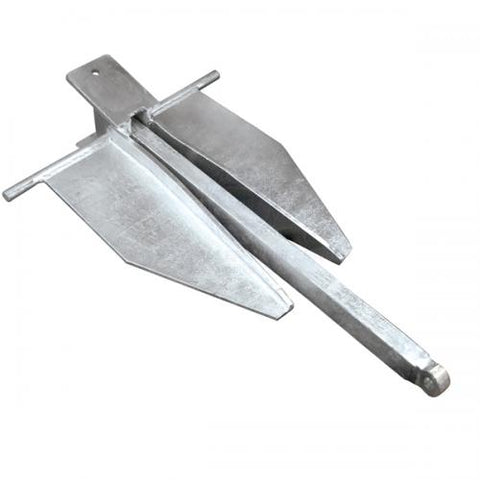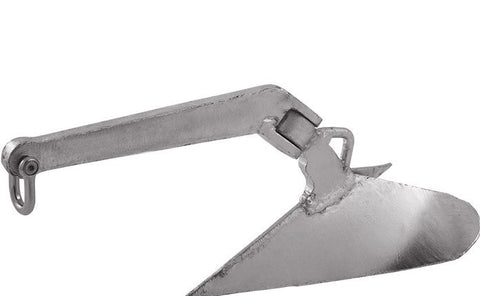Anchors are available in a few different variants. The three most popular ones are sand anchors (also called fluke anchor, lightweight or danforth-style anchors), plough anchors (also called plow, scoop or delta anchors), and reef anchors.
What is the difference between Sand Anchors, Reef anchors vs Plough Anchors?
- Sand anchors are good in sand and mud conditions and come in a variety of weights for boats of different sizes. These are the most popular type anchor is the sand anchor – also called fluke anchor, lightweight or danford style anchors. These light and easy to use anchors are excellent for sand and mud conditions. These anchors have great power to weight ratio, because of which, you can get away with using a lighter anchor compared to other anchor types. However, they don’t hold too well in grassy or rocky bottoms – which is where the plough anchors come in. Sand anchors are a great choice for small boats because of their lightweight characteristics.

-
Plough anchors feature a single-point style and are generally hold more effectively in grass, mud, and sand since they plough into the substrate of the seafloor. They are designed for heavier vessels, which is why they are commonly used as primary anchors by heavier powerboats and cruising sailboats. These anchors feature retrieval eyes for ease of removal if they get snagged, buy since their shape makes stowing more difficult – they require a bow roller. Unlike sand anchors, plough anchors reset themselves easily when the wind or current changes direction. A claw (bruce) anchor works similar to a plough anchor and is designed to self align to the bottom and digs into mud and sand bottoms.

-
Reef anchors, on the other hand, are used for temporary anchoring. While sand and plough anchors lodge into the floor or bottom, reef anchors do not lodge into the ground. Instead, they grab onto things like rocks and coral. When force is applied, the prongs on the end of reef anchors become straight, allowing for easy retrieval. Since reef anchors do not lodge into the ground reef anchored boats should not be left unattended.

How to decide which boat anchor is best for you?
- Boat size and anchor’s weight: Boat size is a crucial factor in selecting an anchor. A small anchor cannot effectively hold a big boat in place while a big anchor on a smaller boat would just be unnecessary weight. Anchors generally have a holding power of 10 to 100 times the anchor’s weight. However, most boat manufacturers or dealers will tell you the appropriate size of anchor for your boat – so do consider that.
- Boat’s use: Anchor selection will depend on where you mainly anchor your boats. If you are going to be in sand and mud conditions, sand anchors are appropriate. If you have a heavier vessel – a plough anchor is more suited. The effectiveness of the anchor has to be considered based on the bottom surface it is anchored. Most anchors specify which surfaces they can be used on, and while both sand and plough anchors work for sand and mud conditions, a plough anchor is more favorable in grass bottoms, and a reef anchor will be needed if you will be anchoring on a reef. A sand or plough anchors will not be effective in reef conditions.
- Anchor’s material: Anchor’s come in 3 materials – galvanized steel, marine-grade 316 stainless steel, and lightweight aluminium. Galvanised anchors are the cheapest ones and have high tensile strength, they are inexpensive, strong, and have are corrosion resistant. But, they can wear down over time and are not as stylish as a stainless steel anchor. The premium choice is a marine-grade 316 stainless steel anchor, and most customers prefer the stainless steel anchors over galvanized anchors for their sheer look, style, and usability. They are strong, look good, and are corrosion resistant. However, they can be expensive and can sustain damages like scratches from repeated use which will take away some of those stylish looks. Sailboat owners prefer to choose the more expensive but lightweight aluminum anchors. Aluminum anchors are more expensive but not as strong as stainless steel anchors.




